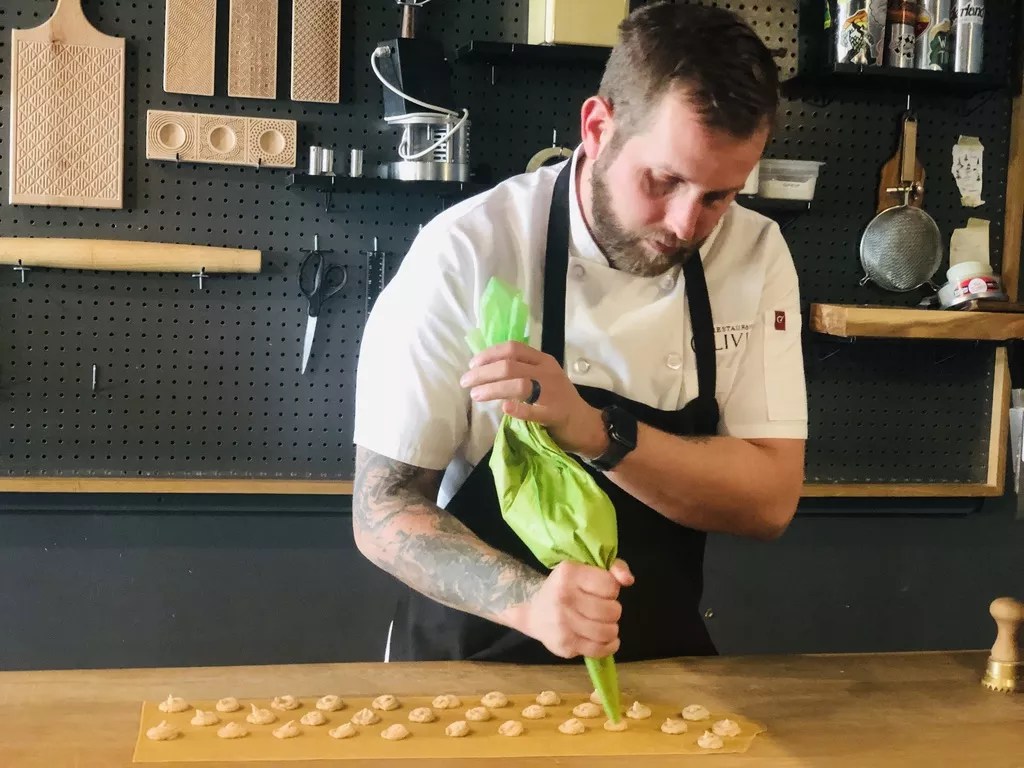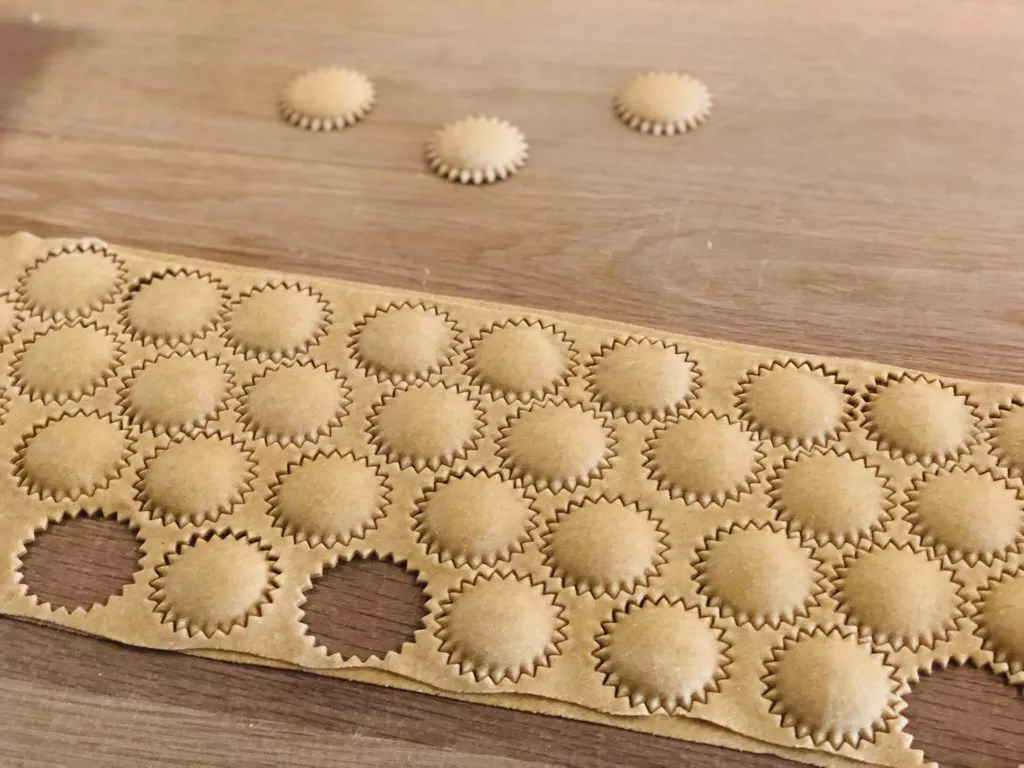
Joni Schrantz

Audio By Carbonatix
January 14 marks five years since Restaurant Olivia made its debut in Wash Park, and over that time, it’s racked up a lot of honors, including becoming a staple on our Best Italian Restaurants list and nabbing the Best of Denver editor’s pick for Best Pasta in 2022.
As the team celebrates the milestone and prepares to open a second restaurant in RiNo, it’s looking back at dozens and dozens of different pasta dishes that have passed through Olivia’s kitchen to diners’ plates – but one staple that has been on the Olivia menu almost from day one is the fan-favorite French onion ravioli.
“I just come out of a deep slumber saying we need to change things,” says Leon. “But the ravioli is never one of those things that I feel like we need to change. We’ve got it down now…not necessarily to a science, but we have our methods and practices. It would be harder to take it off than it is to keep it on. And I don’t think anybody is tired of looking at it.”
What inspired Olivia’s French onion ravioli?
This year, make your gift count –
Invest in local news that matters.
Our work is funded by readers like you who make voluntary gifts because they value our work and want to see it continue. Make a contribution today to help us reach our $50,000 goal!
It doesn’t take an expert in Italian cuisine to figure out that French onion ravioli isn’t exactly a traditional Italian dish. It was originally invented to pay homage to the French restaurant that formerly occupied the Restaurant Olivia space – Cafe Marmotte – and appease loyal customers who were unhappy that their favorite French hangout was going away.
At the same time, Olivia was creating a great deal of vegetable trimming from other dishes, and those trimmings needed a use. That took the form of a vegetable stock so dark and rich that it rivaled the umami essence of beef stock, which needed a use as well. Because Cafe Marmotte’s French onion soup was Olivia co-owner Heather Morrison’s favorite menu item, the team decided to roll with it and create a vegetarian version.
Few remember that this first took the form of arancini – a ball of risotto, stuffed, fried, and served with a cheesy, creamy stock – but eventually, the team shifted to the ravioli format and never turned back.

Chef Ty Leon piping the French ravioli filling onto freshly rolled pasta dough.
Antony Bruno
How Olivia’s French onion ravioli is made
While the time it takes for the French onion ravioli to reach your table after ordering is only a matter of minutes, the reality is that the ravioli got its start at least three days before.
The filling
As with any stuffed pasta, the filling is the first component to create, and it generally take the longest. That’s because it has to both cool and be strained before touching a piece of pasta dough.
Creating it requires julienning some thirty onions – roughly twelve quarts – and slowly caramelizing them, which takes about two hours. Then three gallons of vegetable stock are added and cooked down for another hour to meld the flavors. The onions are then strained and pressed overnight to remove nearly all moisture, bringing the combined stock/onions down to about a gallon of dry, compressed mass.
“If you’re making ravioli with a wet filling, it’s terrible, right?” says Leon. “So we have to push all that moisture out of the onions, and we want something really, really dry.”
The next day, cream and Gruyère cheese are added to the onions, which are cooked down again and then blended into a paste. That brings the previous day’s gallon of onions down to about a quart of final filling, which again is left to sit and firm up overnight before being used for the pasta the next day.

“Pasta Ninja” Emily Longaker makes some fifteen pounds of pasta dough a day.
Courtesy of Restaurant Olivia
The pasta
Day three is all about the pasta, which for a restaurant that only serves fresh pasta is another production in itself. Olivia’s “Pasta Ninja,” Emily Longaker, arrives between 4 and 6 a.m., depending on the day, to get the fresh pasta started.
Longaker cranks out roughly twenty pounds of pasta a day, and no less than one hundred pounds a week. That’s a mix of whole-egg pasta, egg yolk pasta and water/flour pasta. The ravioli uses whole-egg pasta, which makes up about half the day’s yield when its being made.
That’s about fifteen dozen eggs, hand-cracked, every day. The eggs are then mixed with the dough and left to rest. After the dough is rested, it’s portioned out and rolled through a commercial pasta roller into long sheets. One is the bottom sheet on which the filling will be piped. A ring mold is used to measure where to pipe each tablespoon of filling. A second sheet of pasta dough is draped on top, covering the filling, and the air between sheets is gently pressed out.

Hand-stamped French onion ravioli ready for service.
Antony Bruno
Finally, there’s the cutting, using a brass, starburst-shaped ravioli stamp, the inside of which collapses to avoid pressing out the filling in each cut. One person hand-stamps the ravioli, transferring them to a bed of semolina flour before they are placed in the freezer to wait for service. The ravioli are then boiled and served with more vegetable stock and a Gruyère cheese fondue.
Given that Olivia serves some thirty plates of the ravioli a day (that’s 300 pieces of ravioli total), this three-day process is constantly in motion, with each stage overlapping in a continuous, seemingly never-ending cycle.
“It’s weird to walk in here and not have onions caramelizing,” says Leon. “We’re a pasta restaurant. If it can be put inside of a ravioli, tortellini, cappelletti, whatever it might be, we’re gonna do it. We take French onion soup and put it inside of a ravioli. [But] I think what’s hard to understand if you’re not doing this professionally is the amount of time things take to make. “
So the next time you’re at Olivia and order the French onion ravioli, just remember that the signature dish took three days of production work, generally involving the labor of up to four different chefs, with another two to three pairs of hands firing it, plating it and serving it at your table.
To commemorate its fifth anniversary, Restaurant Olivia is offering a special five-course tasting menu that includes its French onion ravioli through January 31. For more information or to make a reservation, visit oliviadenver.com.